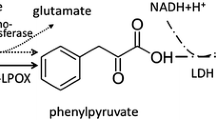Abstract
The first establishment of a homologous expression system in the host Ralstonia pickettii CGMCC1596 using the compatible broad-host-range plasmid pWB5 is described. When whole cells of the recombinant strain R. pickettii MMYY01 (CGMCC1596/pYY05) were used as the biocatalyst to transform dl-4-hydroxyphenylhydantoin (dl-HPH) to d-4-hydroxyphenylglycine (d-HPG), the conversion rate reached 94 % in first 9 h, at a production rate of 2.8 g L−1 h−1, with the rapid reduction of the intermediate [N-carbamoyl-2-(4-hydroxyphenyl)glycine], compared with 80 % in >50 h at a rate of 0.5 g L−1 h−1 for the CGMCC1596. The stability of the recombinant plasmid pYY05 is sufficient for its application in industrial batch fermentation. An alternative strategy for the conversion of dl-HPH to d-HPG by resting CGMCC1596 cells and heterologous DCase expressed by E. coli is discussed.
Similar content being viewed by others
Abbreviations
- Amp:
-
ampicillin
- CGMCC:
-
China General Microbiological Culture Collection Center
- DCase:
-
N-carbamoyl-D-amino-acid-amidohydrolase
- dca :
-
DCase encoding gene
- DHase:
-
d-hydantoinase
- dha :
-
DHase encoding gene
- dha-dca (casette):
-
gene casette encoding both DHase and DCase
- d-HPG:
-
d-4-hydroxyphenylglycine
- NC-d-HPG:
-
N-carbamoyl-d-4-hydroxyphenylglycine
- dl-HPH:
-
dl-4-hydroxyphenylhydantoin
- HPLC:
-
high-performance liquid chromatography
- Km:
-
kanamycin
- PS:
-
parent(al) strain (CGMCC1596)
- RP:
-
recombinant plasmid (pYY05)
- RS:
-
recombinant strain (MMYY01)
- SDS-PAGE:
-
sodium dodecyl sulfate-polyacrylamide gel electrophoresis
- Tc:
-
tetracycline
- WT(s):
-
wild-type strain(s)
References
Buchanan K., Burton S.G., Dorrington R.A., Matcher G.F., Skepu Z.: A novel Pseudomonas putida strain with high levels of hydantoin-converting activity, producing l-amino acids. J.Mol.Catal.B Enzym.11, 397–406 (2001).
Chao Y.P., Fu H., Lo T.E., Chen P.T., Wang J.J.: One-step production of d-p-hydroxyphenylglycine by recombinant Escherichia coli strains. Biotechnol.Progr.15, 1039–1045 (1999).
Chao Y.P., Chiang C.J., Lo T.E., Fu H.: Overproduction of D-hydantoinase and carbamoylase in a soluble form in Escherichia coli. Appl.Microbiol.Biotechnol.54, 348–353 (2000).
Chen H.Y., Tsai H.: Cloning, sequencing, and expression in Escherichia coli of d-hydantoinase gene from Pseudomonas putida. Ann. N.Y.Acad.Sci.864, 234–237 (1998).
Figurski D.H., Helinski D.R.: Replication of an origin-containing derivative of plasmid RK2 dependent on a plasmid function provided in trans. Proc.Nat.Acad.Sci.USA76, 1648–1652 (1979).
Hanahan D.: Studies on transformation of Escherichia coli with plasmids. J.Mol.Biol.166, 557–580 (1983).
Hils M., Munch P., Altenbuchner J., Syldatk C., Mattes R.: Cloning and characterization of genes from Agrobacterium sp. IP I-671 involved in hydantoin degradation. Appl.Microbiol.Biotechnol.57, 680–688 (2001).
Jiang S., Li C., Zhang W., Cai Y., Yang Y., Yang S., Jiang W.: Directed evolution and structural analysis of N-carbamoyl-d-amino acid amidohydrolase provide insights into recombinant protein solubility in Escherichia coli. Biochem.J.402, 429–437 (2007).
Las Heras-Vazquez F.J., Martinez-Rodriguez S., Mingorance-Cazorla L., Clemente-Jimenez J.M., Rodriguez-Vico F.: Overexpression and characterization of hydantoin racemase from Agrobacterium tumefaciens C58. Biochem.Biophys.Res. Commun.303, 541–547 (2003).
Martinez-Rodriguez S., Las Heras-Vazquez F.J., Clemente-Jimenez J.M., Mingorance-Cazorla L., Rodriguez-Vico F.: Complete conversion of d,l-5-monosubstituted hydantoins with a low velocity of chemical racemization into d-amino acids using whole cells of recombinant Escherichia coli. Biotechnol.Progr.18, 1201–1206 (2002).
Martinez-Rodriguez S., Heras-Vazquez F.J.L., Clemente-Jimenez J.M., Rodriguez-Vico F.: Biochemical characterization of a novel hydantoin racemase from Agrobacterium tumefaciens C58. Biochimie86, 77–81 (2004).
Miller J.H.Experiments in Molecular Genetics. Cold Spring Harbor Laboratory 1972.
Neal R.J., Griffin A.M., Scott M., Shatzman A.R., Gorham H.C.: d-N-Carbamyl amino acid amidohydrolase and hydantoinase. Internat. Pat. Publ. no. WO 94/00577 (1994).
Nozaki H., Takenaka Y., Kira I., Watanabe K., Yokozeki K.: d-Amino acid production by E. coli co-expressed three genes encoding hydantoin racemase, d-hydantoinase and N-carbamoyl-d-amino acid amidohydrolase. J.Mol.Catal.B-Enzym.32,213–218 (2005).
Olivieri R., Fascetti E., Angelini L., Degen L.: Microbial transformation of racemic hydantoins to d-amino acids. Biotechnol.Bioeng.23, 2173–2183 (1981).
Park J.H., Kim G.J., Kim H.S.: Production of d-amino acid using whole cells of recombinant Escherichia coli with separately and coexpressed d-hydantoinase and N-carbamoylase. Biotechnol.Progr.16, 564–570 (2000).
Qi C., Luo X.: Methods of producing D-amino acids. Chinese Pat. CN 871 081 40A (1988).
Sambrook J., Fritsch E.F., Maniatis T.: Molecular Cloning: a Laboratory Manual, 2nd ed. Cold Spring Harbor Laboratory Press, Cold Spring Harbor (NY, USA) 1989.
Suzuki S., Onishi N., Yokozeki K.: Purification and characterization of hydantoin racemase from Microbacterium liquefaciens AJ 3912. Biosci.Biotechnol.Biochem.69, 530–536 (2005).
Vanbleu E., Marchal K., Vanderleyden J.: Genetic and physical map of the pLAFR1 vector. DNA Seq.15, 225–227 (2004).
Watabe K., Ishikawa T., Mukohara Y., Nakamura H.: Purification and characterization of the hydantoin racemase of Pseudomonas sp. strain Ns671 expressed in Escherichia coli. J.Bacteriol.174, 7989–7995 (1992).
Wiese A., Pietzsch M., Syldatk C., Mattes R., Altenbuchner J.: Hydantoin racemase from Arthrobacter aurescens DSM 3747: heterologous expression, purification and characterization. J.Biotechnol.80, 217–230 (2000).
Xu Z., Liu Y., Yang Y., Jiang W., Arnold E., Ding J.: Crystal structure of d-hydantoinase from Burkholderia pickettii at a resolution of 2.7 ångströms: insights into the molecular basis of enzyme thermostability. J.Bacteriol.185, 4038–4049 (2003).
Author information
Authors and Affiliations
Corresponding author
Rights and permissions
About this article
Cite this article
Yu, H., Yang, S., Jiang, W. et al. Efficient biocatalytic production of d-4-hydroxyphenylglycine by whole cells of recombinant Ralstonia pickettii . Folia Microbiol 54, 509–515 (2009). https://doi.org/10.1007/s12223-009-0073-y
Received:
Revised:
Published:
Issue Date:
DOI: https://doi.org/10.1007/s12223-009-0073-y




